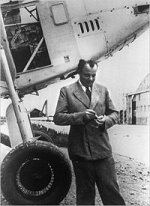|
 Famed as both aviator and author, Antoine Jean-Baptiste Marie Roger de Saint-Exupery was born in Lyon, France to an old provincial noble family. Never very interested in traditional education, he later enrolled in the Ecole des Beaux-Arts to study architecture. In 1921 he entered military service in a cavalry division but was soon transferred to train as a pilot in the French Air Force. His family and fiancee, the future novelist Louise Leveque de Vilmorin, disapproved of his interest in aviation, so for a time he settled down to an office job in Paris. Saint-Exupery could not let go of his dreams of flight, however, so the couple eventually broke their engagement. Famed as both aviator and author, Antoine Jean-Baptiste Marie Roger de Saint-Exupery was born in Lyon, France to an old provincial noble family. Never very interested in traditional education, he later enrolled in the Ecole des Beaux-Arts to study architecture. In 1921 he entered military service in a cavalry division but was soon transferred to train as a pilot in the French Air Force. His family and fiancee, the future novelist Louise Leveque de Vilmorin, disapproved of his interest in aviation, so for a time he settled down to an office job in Paris. Saint-Exupery could not let go of his dreams of flight, however, so the couple eventually broke their engagement.
By 1926 St. Exupery was flying again, and he quickly achieved fame as a pioneer of international postal flight. His efforts were considered particularly brave and heroic since, in those days, few if any flight instruments were available to assist pilots. His primary flight route was the Aeropostale between Toulouse and Dakar. Later on, after flight instruments became available, Saint-Exupery complained that pilots who used them were more like accountants than pilots. It was around this time that Saint-Exupery decided to write about his experiences as an aviator. His first story, "L'Aviateur," was published in magazine format, and in 1929 he published his first book, Courrier Sud (Southern Mail). His aviation career continued to grow as well, and also in 1929 he flew the Casablanca/Dakar route and became the director of Cape Juby airfield in Rio de Oro, Morocco. He then moved to South America, where he was appointed director of the Aeroposta Argentina Company. The first of his major works and the winner of the Prix Femina, Vol de Nuit (Night Flight) was published in 1931 and covers his experiences with the Aeropostale. Also that year he married Consuelo Gomez Carillo, a Salvadoran writer and artist. It was a difficult marriage, since Saint-Exupery traveled frequently and conducted a number of extra-marital affairs.
It was on one of those travels far from his wife that he experienced a serious plane crash. The year was 1935, and Saint-Exupery, along with his navigator, Andre Prevot, crashed in the Libyan Sahara desert en route to Saigon. The team was attempting to break a record in order to achieve additional fame as well as earn a prize of 150,000 francs. Both men survived the crash, but landing in the Sahara could have meant a death sentence, nonetheless. They had no idea of their location. According to Saint-Exupery's memoir, Wind, Sand, and Stars, their sole supplies were grapes, one orange, and a ration of wine. However, immediately following his rescue, Saint-Exupery told the press that the men had only a thermos of sweet coffee, chocolate, and a handful of crackers, enough to survive for only one day. They experienced visual and auditory hallucinations and by day three were so dehydrated they ceased to sweat. At last, on day four, a Bedouin discovered them and saved their lives. Saint-Exupery's story, Le Petit Prince (The Little Prince), which begins with a pilot being marooned in the desert, is in part a reference to this experience. The story is semi-autobiographical philosophical tale, including social criticism of the adult world.
Saint-Exupery continued to write and to fly until World War II, when he served in the French Air force. Once France fell to the Germans, he went to live in the United States and Canada. He wrote The Little Prince in the 1942. Following his two years living abroad, St. Exupery returned to Europe to fly with the Free French Forces and fight with the Allies in a Mediterranean-based squadron. By now he was 43, older than most military pilots assigned such duties. He suffered a good deal of physical pain at this time, due to old fractures. He was assigned the P-38 Lightning aircraft, described by an officer as "war-weary, non-airworthy craft." St. Exupery's final assignment was to collect intelligence on German troop movements. On the evening of July 31, 1944, he left an airbase in Corsica, and was never seen again. There were a few reported sightings, and an unidentifiable body wearing French colors was found and buried near Toulon. In 1998, a fisherman found a silver identity bracelet bearing the names of Saint-Exupery and his wife Consuelo and his publishers. It was found hooked to a piece of fabric, presumably from his flight suit. In 2000, through the efforts of divers and archaeologists, Saint-Exupery's plane was discovered crashed in the seabed off the coast of Marseille. The location of the crash site and bracelet are less than 80km by sea from there the unidentified French soldier was found and buried in 1944.
Image: Antoine de Saint-Exupery, from Agence France-Presse.
|